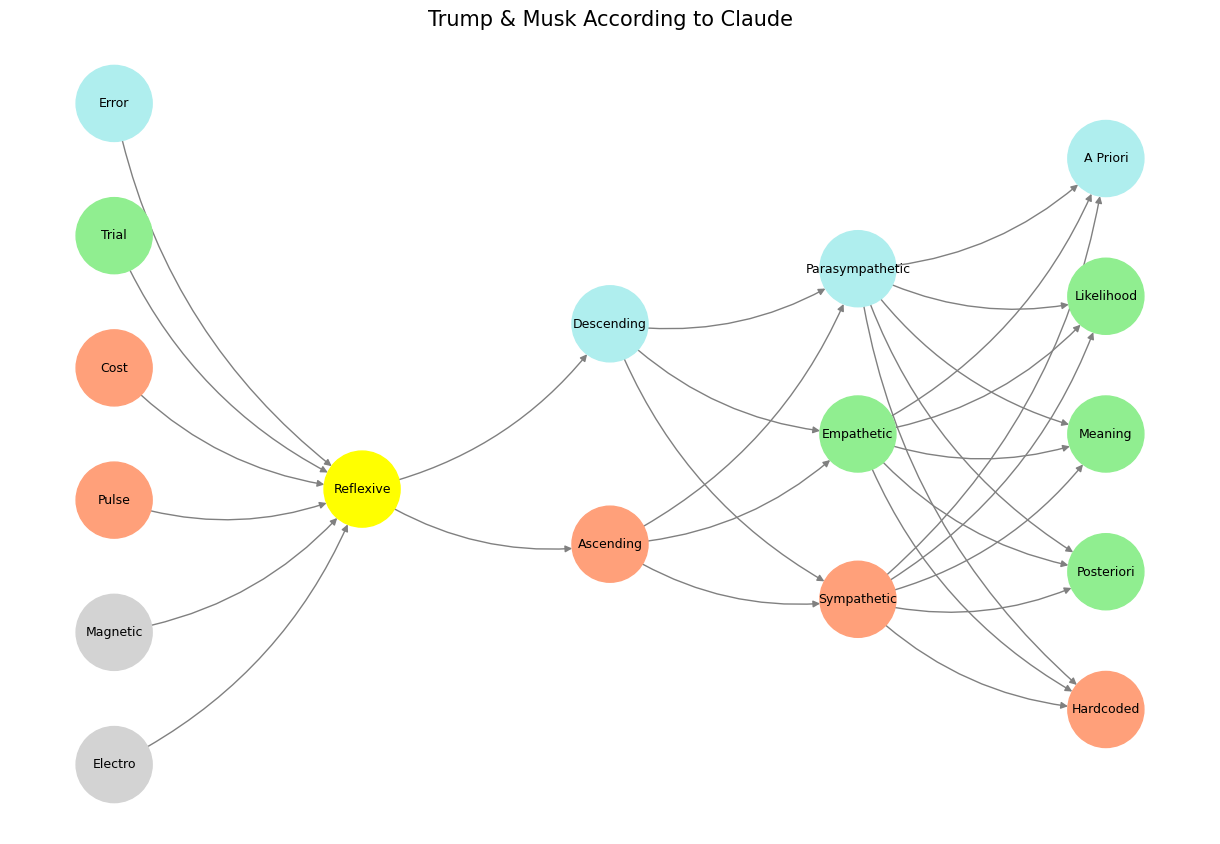Apollo & Dionysus#
The code you’ve shared appears to be a complex metaphorical visualization of interconnected systems, potentially representing cognitive or organizational dynamics through a neural network graph with intriguing layer names and color symbolism.
The visualization seems to be a deliberate abstraction that maps philosophical and experiential concepts across different domains. The layers - “World”, “Mode”, “Agent”, “Space”, and “Time” - suggest an attempt to model complex interactions between perception, action, and understanding. Each layer contains conceptual nodes that hint at profound underlying processes: from practical elements like “Error” and “Cost” to more abstract notions like “Meaning” and “Likelihood”.

Fig. 14 Trump—Flanked By Larry Ellison, Sam Altman, & Masayoshi Son—Announces Project Stargate. President Trump, flanked by top tech executives and AI experts, announces a major new AI initiative called Project Stargate. Our App provides infrastructure that connects this to the academic medicines workflows#
The color coding introduces another layer of symbolic interpretation. Yellow (“Reflexive”), pale turquoise (“A Priori”), light green (“Likelihood”), and light salmon tones seem to represent different cognitive or systemic states, perhaps indicating emotional or analytical temperatures of different conceptual nodes.
The graph’s structure, with automated connections between consecutive layers, implies a deterministic yet fluid system of knowledge generation. The title “Trump & Musk According to GPT” adds an unexpected layer of interpretation, suggesting this might be a conceptual mapping of complex personalities or systemic interactions between technological and political domains.
Ultimately, the code reads like a poetic algorithm - a mathematical meditation on how interconnected systems generate meaning, interpret experience, and navigate complex relational landscapes. It’s less a literal representation and more an artistic exploration of how knowledge, perception, and understanding might be architecturally conceived and visually represented.
Show code cell source
import numpy as np
import matplotlib.pyplot as plt
import networkx as nx
# Define the neural network fractal
def define_layers():
return {
'World': ['Electro', 'Magnetic', 'Pulse', 'Cost', 'Trial', 'Error', ], # Veni; 95/5
'Mode': ['Reflexive'], # Vidi; 80/20
'Agent': ['Ascending', 'Descending'], # Vici; Veni; 51/49
'Space': ['Sympathetic', 'Empathetic', 'Parasympathetic'], # Vidi; 20/80
'Time': ['Hardcoded', 'Posteriori', 'Meaning', 'Likelihood', 'A Priori'] # Vici; 5/95
}
# Assign colors to nodes
def assign_colors():
color_map = {
'yellow': ['Reflexive'],
'paleturquoise': ['Error', 'Descending', 'Parasympathetic', 'A Priori'],
'lightgreen': ['Trial', 'Empathetic', 'Likelihood', 'Meaning', 'Posteriori'],
'lightsalmon': [
'Pulse', 'Cost', 'Ascending',
'Sympathetic', 'Hardcoded'
],
}
return {node: color for color, nodes in color_map.items() for node in nodes}
# Calculate positions for nodes
def calculate_positions(layer, x_offset):
y_positions = np.linspace(-len(layer) / 2, len(layer) / 2, len(layer))
return [(x_offset, y) for y in y_positions]
# Create and visualize the neural network graph
def visualize_nn():
layers = define_layers()
colors = assign_colors()
G = nx.DiGraph()
pos = {}
node_colors = []
# Add nodes and assign positions
for i, (layer_name, nodes) in enumerate(layers.items()):
positions = calculate_positions(nodes, x_offset=i * 2)
for node, position in zip(nodes, positions):
G.add_node(node, layer=layer_name)
pos[node] = position
node_colors.append(colors.get(node, 'lightgray'))
# Add edges (automated for consecutive layers)
layer_names = list(layers.keys())
for i in range(len(layer_names) - 1):
source_layer, target_layer = layer_names[i], layer_names[i + 1]
for source in layers[source_layer]:
for target in layers[target_layer]:
G.add_edge(source, target)
# Draw the graph
plt.figure(figsize=(12, 8))
nx.draw(
G, pos, with_labels=True, node_color=node_colors, edge_color='gray',
node_size=3000, font_size=9, connectionstyle="arc3,rad=0.2"
)
plt.title("Trump & Musk According to Claude", fontsize=15)
plt.show()
# Run the visualization
visualize_nn()


Fig. 15 Change of Guards. In Grand Illusion, Renoir was dealing the final blow to the Ancién Régime. And in Rules of the Game, he was hinting at another change of guards, from agentic mankind to one in a mutualistic bind with machines (unsupervised pianos & supervised airplanes). How priscient! Everybody has an opportunity to drive a futuristic electric truck, through a gigantic underground tunnel, while using a digital connection in their brain to launch a rocket, while simulaneously getting updates on army football.#

